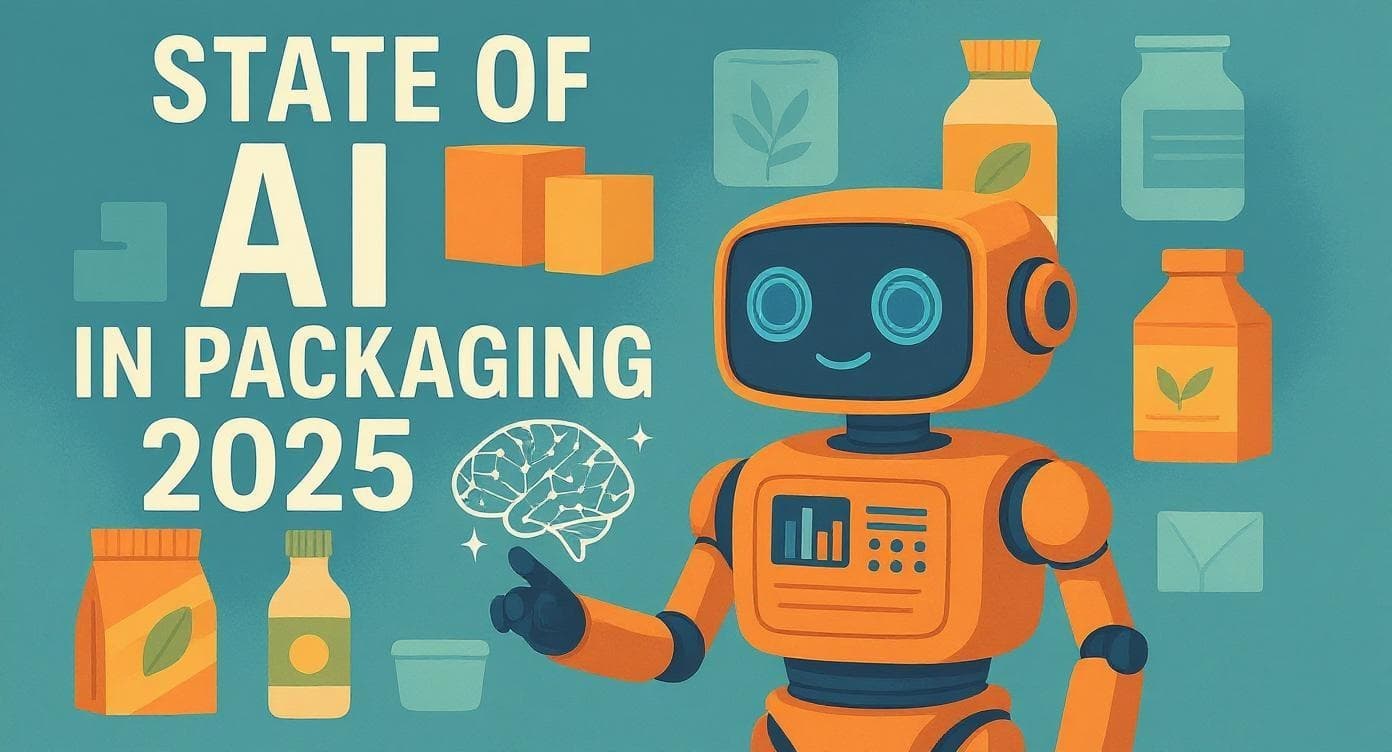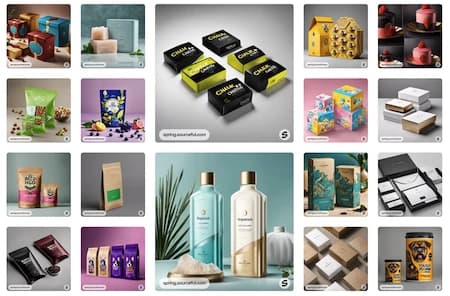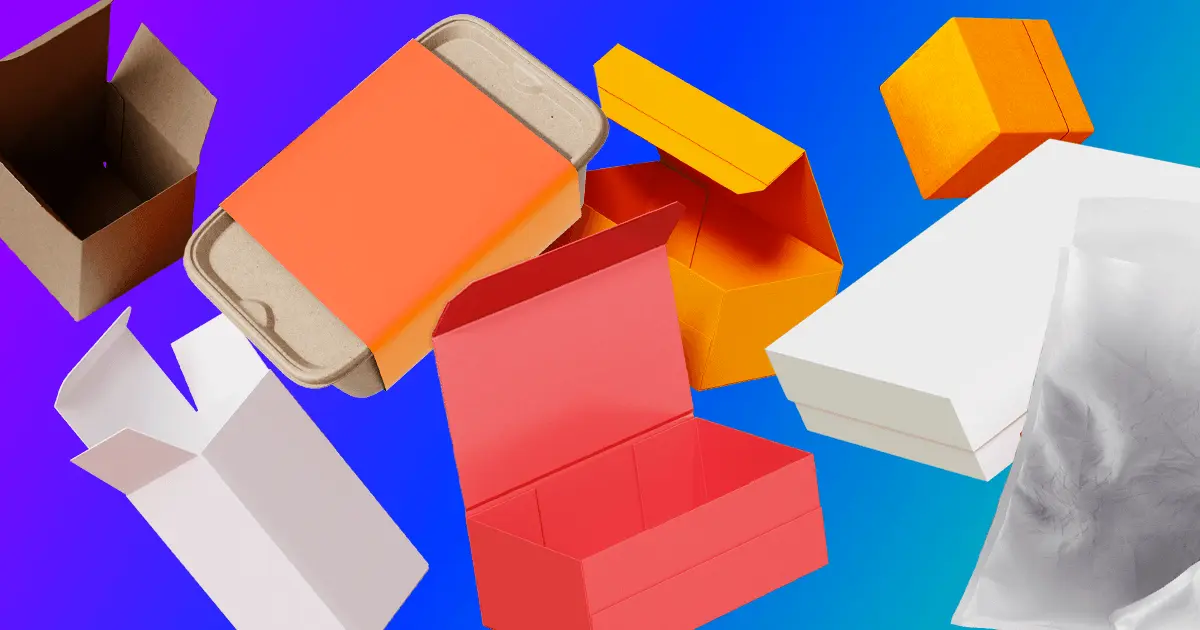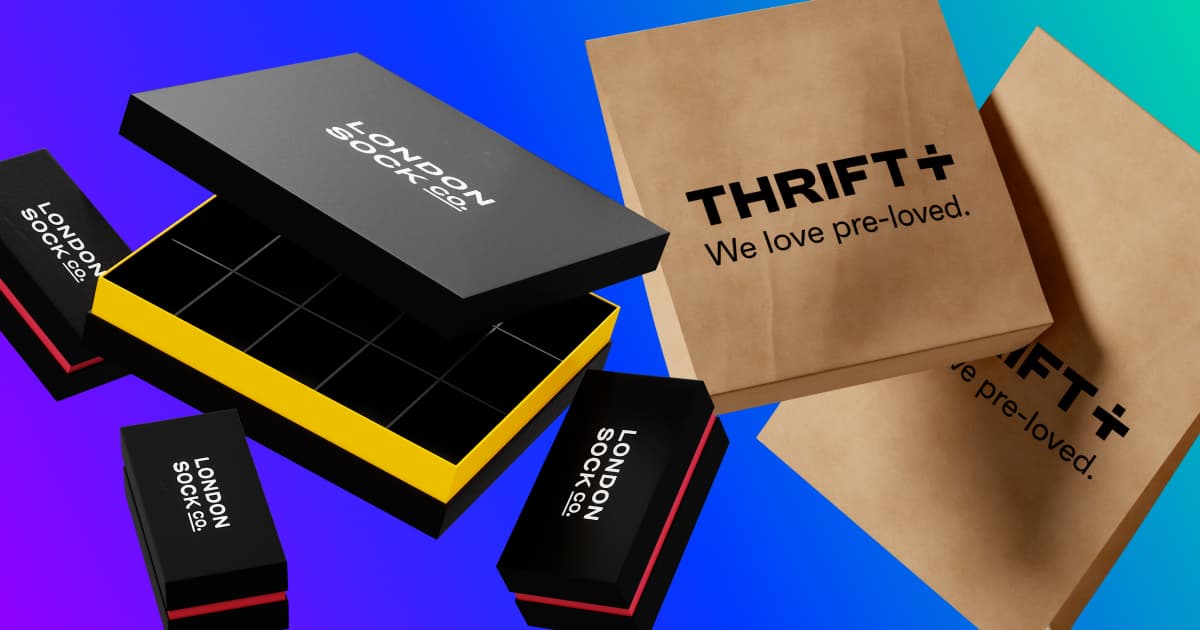Blog Post18 more eco-friendly packaging ideas in 2023
- Design
- Materials
- Sustainability
Clare AndertonFebruary 7, 2023 - 8 min read
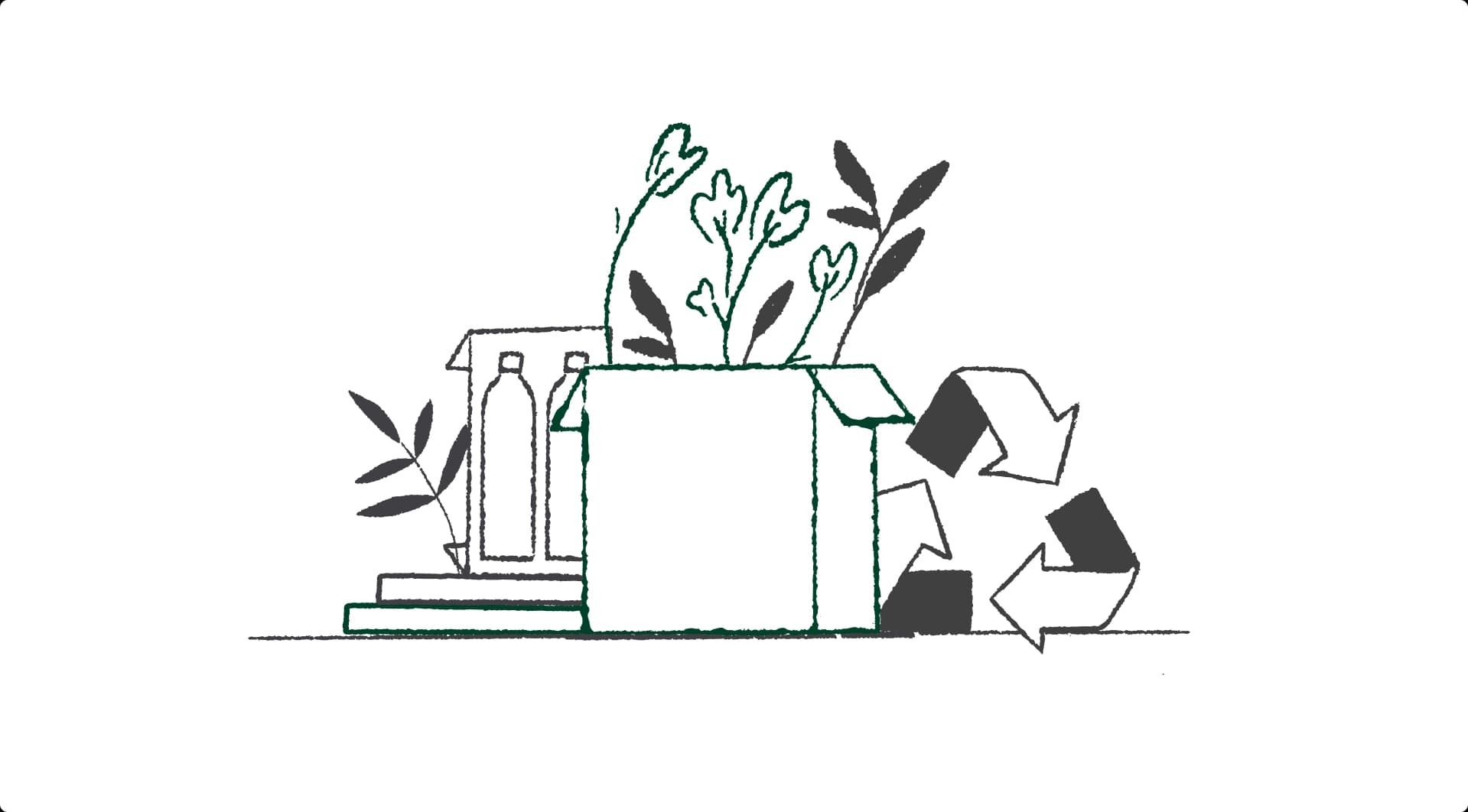
As e-commerce grows, so does packaging waste. In response, governments around the world are cracking down as extended producer responsibility becomes more widespread. The result? More brands seeking ways to stay ahead of regulations by creating more sustainable packaging.
Recycled materials, intelligent design and creative, novel solutions can make this a possibility. Here, we dig into eighteen ideas for making your packaging more sustainable, what other businesses are doing, and how we at Sourceful can help you make the switch.
More sustainable packaging ideas for 2023
- Recycled packaging
- Upcycling
- Returnable packaging
- Mono-materials
- Reduced packaging size
- Reusable bags
- Eco-friendly packaging tape
- Edible packaging
- Furoshiki
- Foliage
- Minimalism
- Natural inks
- Smart labels
- Intelligent packaging
- Active packaging
- Carbon-neutral shipping
- Sea freight
- Limited return shipping
1. Recycled packaging
Recycled packaging refers to packaging that's been made from previously used materials, such as card, paper, glass, metal and certain plastics. In the packaging industry, corrugated cardboard is one of the most frequently recycled materials and is used to create paper and card products. And of course — more boxes.
Many cities and counties in the UK have recycling programs that can accept a variety of materials. In fact, 2021 data shows that 63% of the UK’s packaging waste is collected for recycling. Customers can find the range of recycling labels confusing, so it's always helpful to include clear recycling instructions on your packaging.
Sourceful's recycled mailer bags, which contain up to 98% recycled plastic, are a great example of how plastic can be given a second life. What’s more, using one of our recycled mailer bags instead of a virgin poly mailer bag can reduce your carbon footprint by up to 30%.
Using packaging made from recycled materials conserves resources and makes for a more sustainable option than those made from virgin materials.
2. Upcycling
Upcycling, or repurposing, involves taking materials that you would have otherwise discarded and turning them into new products. This is a chance to get really creative! For example, you can turn an old t-shirt into a tote bag with just a pair of scissors in less than ten minutes.
Sourceful's shipping boxes are the ideal upcycling candidate. You could encourage your customers to turn them into a cosy pet bed, a picture frame or even a planter for plants and flowers. With corrugated cardboard the possibilities are endless.
3. Returnable packaging
Returnable packaging is packaging that can be returned to the manufacturer or the distributor after use. A common example in the packaging industry is reusable crates and pallets. But returnable packaging is becoming more popular in retail too.
When set up in the right way, it can drive high return rates and long product lifetimes. For example, Boots offers loyalty points to customers who return packaging they can’t recycle at home. Boots then recycles the packaging into new products.
Meanwhile, RePack offers a closed-loop system that keeps all waste products out of landfill and turns them into something new. In a closed-loop system, packaging can be returned, recycled and even upcycled into completely different products.
Making packaging returnable helps us move from a linear economy toward a circular one. In a circular future, waste is a valuable resource that reduces the need for virgin materials and reduces the pressure on the planet.
4. Mono-materials
Mono-material packaging is packaging made from just one material. The advantage of this is that it can be easier to recycle, which reduces the chance of it ending up in general waste and in turn landfill.
Packaging manufacturer Mondi has helped Handl Tyrol, a food producer, reduce its plastic waste and increase its packaging’s recyclability by creating food-safe mono-material packaging.
5. Reduced packaging size
Reducing packaging size involves looking at whether you’re shipping air in your packaging and then reducing its size accordingly. This helps you use less packaging material and also allows you to ship more of your product at any one time, saving emissions costs in the process.
Furniture giant Ikea reconfigured their packaging and now saves €1.2 million, uses fewer materials and has removed 7747 trucks from the road annually. Proof that reducing packaging size can be both more sustainable and good for business.
At Sourceful, some of our most popular packaging can be custom-sized to fit your product’s exact specifications:
6. Reusable bags
Reusable bags are bags that can be used for years before they need to be replaced or disposed of. If you’ve shopped in a supermarket in the last year, you’ll know that there’s now a 10p charge on single-use plastic bags, and that customers are encouraged to bring their own.
“Bag for Life” is a term many people are now familiar with. This can refer to fabric bags and those made from more durable plastic. Encouraging customers to bring their own bags reduces the need to produce new bags and stops waste from going to landfill.
7. Eco-friendly packaging tape
The most sustainable packaging tapes are those made from paper and use natural adhesives. But the first step towards being more eco-friendly is to see if you can reduce your material use by using less tape and fewer labels. If that’s not practical, using a more sustainable alternative is the next best thing.
Sourceful's gummed tape has a 40-50% lower carbon footprint than traditional plastic packaging. It’s made from FSC-certified paper, which can be recycled and made into new paper products after use. We also use a starch-based adhesive to make it sticky, which is a natural, renewable resource that doesn’t affect recyclability.
What’s more, our gummed tape can do the job of both a tape and a label as you can print your logo or other information on it.
8. Edible packaging
Nature is full of its own edible packaging, such as the skin of an apple or a cucumber.
And edible packaging in the packaging world isn't that different. Just like apple skin, this packaging is designed to be consumed along with the product. It can be made of fruit peels, leaves, and films made of starch or protein. Using edible packaging can replace non-renewable packaging, such as plastic, and subsequently reduce waste.
You might have already seen some edible packaging if you’ve watched marathon runners grabbing hand-sized transparent pouches containing drinks. Notpla is a company that uses seaweed to create an edible bubble. This natural, renewable resource can replace plastic bottles and sachets.
9. Furoshiki
Furoshiki is the traditional Japanese practice of wrapping gifts in cloth, which can be used again either by the giver or the receiver of the gift. The fabric can then be used to wrap another gift or in many other ways including handkerchiefs, bandanas and decorations. This practice reduces the need for single-use packaging, which in turn reduces waste and saves the energy required for waste processing.
The Furoshiki Wrap Company sells ready-made wraps in a range of sizes. Though of course, you could use any fabric you have at home in order to avoid purchasing new products.
10. Foliage
Using foliage as packaging involves using twigs, leaves and branches to protect or add a decorative element to your product. The advantage of using foliage is that it’s natural, can be sourced locally and can reduce your packaging’s carbon footprint.
Supermarkets around the world are beginning to replace plastic packaging with natural packaging, such as banana leaves. These break down naturally and can be disposed of with other organic waste.
11. Minimalism
Minimalism involves looking at what protection your product really needs, and then using as little packaging as possible. This could mean using fewer exterior materials, reducing packaging layers or reducing interior materials such as void fillers.
At Sourceful, we have a team of sustainability and packaging experts who can advise you on minimising your packaging whilst still protecting your product.
12. Natural inks
Natural inks, such as water, soy or vegetable-based inks are a more natural choice than petroleum-based inks. The main carrier is naturally derived, they are non-toxic, and producing them creates fewer harmful emissions.
We work with a range of inks to help you make your packaging more sustainable. We use vegetable inks for custom designs on our mailer boxes and water-based inks on our shipping boxes. And our stickers use soy-based inks and are great to use as part of your branding strategy.
13. Smart labels
Smart labels, like scannable QR codes, make packaging interactive. These provide information about the product or about the packaging itself, such as recycling instructions. Using smart labels helps you to reduce your carbon footprint as you can use fewer materials in your packaging.
Smart labels can also be used as advertising to drive brand loyalty. For example, sandwich franchise Pret a Manger uses QR codes that it prints on its coffee cups. These lead customers to a coffee subscription page — a neat way to build their membership base.
14. Intelligent packaging
As well as QR codes, intelligent packaging includes sensor tags. These can monitor the condition of perishable goods, such as food products and pharmaceuticals, and can reduce waste. What’s more, both sensor tags and QR codes can help you track the journey of your products, informing you of inefficiencies in your supply chain and helping you optimise it.
15. Active packaging
Active packaging is packaging that interacts with its contents, extending its shelf life and optimising for quality and freshness. Active packaging can be used in different ways, depending on a product’s need. For example, it can absorb oxygen from the air inside the packaging, keeping its contents fresher for longer. Or it could release antimicrobial agents to stop bacteria and mould from spreading.
A great example of active packaging is Essentra’s Aquasense labels, which can be used to control the moisture levels inside the packaging, keeping their products fresh for longer.
16. Carbon-neutral shipping
Aside from the packaging itself, you can also make your packaging more sustainable by offsetting the emissions generated during transit. Whether your suppliers are local or further afield, offsetting your packaging’s emissions can help you make progress toward net zero.
At Sourceful, we work with some of the world's best carbon removal projects like Charm Industrial and Running Tide. Their projects permanently remove carbon from the atmosphere, which initiatives such as tree planting don’t do, making them a truly long-term solution.
17. Sea freight
Shipping in bulk involves shipping larger quantities of your product at any one time. This can help reduce the emissions generated during transit and can help you save on transport costs.
And the most efficient and sustainable way to ship in bulk is by choosing sea freight. As container ships are large, you can ship more of your product in one go. It is also cheaper than air freight and produces 47 times fewer emissions.
18. Limited return shipping
By limiting return shipping, you can reduce the carbon emissions of your packaging as it won't have to make a second journey. But this doesn't mean not offering your customers refunds if they’re dissatisfied. It actually means making sure they have all the information they need to make an informed purchase, and that your product arrives in the best condition.
Inspecting the product before it’s packaged, providing accurate product descriptions and ensuring the right level of packaging can all make sure your customer is happy when they receive your product.
How to choose the most sustainable packaging for your business
Knowing how different businesses in your industry use eco-friendly packaging can give you the inspiration you need to switch to more sustainable alternatives. But it’s also important for you to balance your sustainable values with your business priorities.
So, before making any changes, it can help to take a step back to consider what you’re already working with and what practical changes you can make.
1. Conduct customer research
Knowing what your customers value can shape your design decisions. For example, they might appreciate 100% recycled materials over virgin materials, giving you the confidence to make the switch. Or, they might fully embrace the concept of Furoshiki packaging.
They may also be prepared to pay more if they knew it meant investing in a business with a commitment to sustainability. This could allow you to increase your prices to cover any additional costs in changing your design or processes.
2. Re-evaluate the protection your product needs
Considering what your product is made of and what protection it needs can help you make the best sustainable switch for your business.
For example, you might be shipping clothes in boxes but find you can reduce the packaging size or forgo most of it altogether. Or you may find that a recycled mailer bag can do the job of a shipping box (if your product isn't fragile) just as well, whilst allowing you to ship less air and increase your packaging’s efficiency.
3. Calculate your carbon footprint
It’s hard to make informed decisions without having the data to back them up. This is where Sourceful's Impact Engine can help you. As you create your packaging online, you’ll see live carbon footprint data, as well as price and lead time information. This can guide your design choices to help you to make your packaging as sustainable as possible.
Create more sustainable packaging with Sourceful
With increasing regulations and pressure from customers, brands need to do all they can to make their packaging more sustainable. Fortunately, from traditional recycled cardboard to intelligent sensors, there’s a host of options out there to help you make the switch.
To find out how Sourceful can help you, head to our shop to browse the full range of packaging.
FAQs
Why aren’t more biodegradable and compostable items on this list?
We haven’t listed many packaging materials that claim to be biodegradable or compostable because this messaging can be misleading.
These terms make it sound as if biodegradable or compostable materials can easily break down in nature in a short time frame, without leaving any residue. But often they require specific conditions to do this only available via industrial processing. When left to break down in the wrong environment, they can stay around for much longer than intended (or advertised), releasing greenhouse gases such as methane and toxic chemicals as they slowly decompose.
What are the alternatives to traditional packaging?
There's an almost endless list of materials that you can use to replace unsustainable ones. Corrugated cardboard, for example, which we use for shipping and mailer boxes, is the one of the most sustainable options as it’s FSC-certified and fully recyclable.
You can also switch out what’s inside your packaging to make it more sustainable. For example, replacing styrofoam inserts with sugarcane pulp ones.
Does more sustainable packaging mean compromising on appearance?
Not at all. You can showcase your brand’s personality just as easily but with the added bonus of reducing your environmental impact. Sourceful's mailer boxes are a great example of low-impact custom packaging that you can use to create an impressive unboxing experience.
If you’d like to see what's possible, try Studio, Sourceful's online design tool where you can visualise your best packaging ideas in minutes.
Is it expensive to switch to more sustainable packaging?
Switching to sustainable packaging doesn’t have to be expensive. Just like Ikea, you can actually save on materials, shipping space and money by making your packaging more efficient.
Learn more: What's the cost of more sustainable packaging in 2023?



